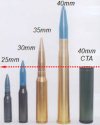Legacy programs built for the conflicts in Afghanistan and Iraq are looking less like vital capabilities and more like bill-payers for the Army, as the
towards a focus on conflict with
.
In a small Tuesday roundtable with reporters, Army Secretary Mark Esper fielded a number of questions about the future of the
and the CH-47 Block II Chinook, a line of inquiry he tied into a recent meeting between Army leadership and officials at U.S.
.
According to Esper, the Army reached out to INDOPACOM leadership to request a meeting, which eventually happened in Hawaii, in order to discuss how the service is developing capabilities to match up with China.
The idea, Esper said, is to make sure that as INDOPACOM head Adm. Phil Davidson is developing war plans, he “takes into consideration what the Army anticipates bringing to the table.”
Asked which capabilities he sees as vital to the Pacific, Esper identified
as “front and center,” which would be used to “hold at bay” Chinese ships. He then added future vertical lift, air and missile defense, and modernized networks as other key areas they briefed INDOPACOM on.
Those capabilities are “something that he needs to know about and he needs to know our thinking where that is in the modernization timeline and everything. So as he thinks about his war plans for the out years, he can calculate those in. and by the same token, it’s an exchange — he can tell us ‘here’s what I’m looking for, here’s what I think I would need,’ and we can adjust our plans as well.”
That discussion happens as the service intends to cut the planned JLTV buy and end procurement of the CH-47 Block II for conventional forces, something Esper said was a direct result of the Army leaning into the National Defense Strategy.
Those two vehicles were designed and procured in “the context of Afghanistan and Iraq,” and hence just not as relevant anymore, Esper said.
“Why the [CH-47s]? Got to carry a heavier payload and fly higher in a hotter climate. What was the heavier payload? JLTV. What drove JLTV? IEDs in Afghanistan and Iraq,” Esper argued. “In many ways they were designed for a different conflict. Doesn’t mean we won’t use them in future conflicts, but now my emphasis has to be on rebuilding my armor, rebuilding my fighting vehicles, having aircraft that can
, that can shoot down Russian and Chinese drones and missiles and helicopters and fixed-wing aircraft.
“We’re in this transition period and some folks are caught in that transition, and that’s what we’re up against.”
More specifically, Esper said there were “no” plans to re-look at the CH-47 decision, and acknowledged that the JLTV total figure is a bit of a moving target.
“We are certainly cutting the total number” of JLTV procurement, which had previously been set at 49,000, Esper said. “I know that much. But whether it settles out, finals out right here, today, I can’t tell you. In five years, I could maybe have a different number for you.”




